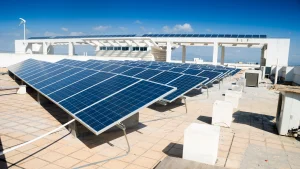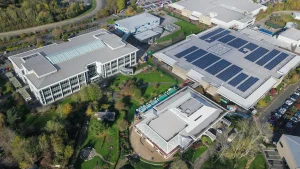Commercial Rooftop Solar Engineering Guide 2025: Flat vs Slope

Why 67% of Commercial Solar Projects Fail Engineering Reviews: The Ultimate Guide to Flat vs. Sloped Roof Installations in 2025
The commercial rooftop solar engineering boom isn’t slowing down. With installations jumping 34% year-over-year in 2025, every EPC and installer is chasing those lucrative rooftop contracts. But here’s the reality check: two-thirds of commercial projects hit engineering roadblocks that could’ve been avoided with proper planning.
Whether you’re eyeing Walmart’s expansive flat rooftops or Amazon’s sloped warehouse complexes, understanding the engineering fundamentals separates successful installers from those stuck in permit hell. This guide breaks down everything you need to know about commercial rooftop solar engineering in 2025.
The Tale of Two Roof Types: Engineering Challenges That Matter
Commercial rooftop solar isn’t one-size-fits-all. The engineering approach for a 500kW system on a flat big-box store differs dramatically from a similar installation on a sloped manufacturing facility. These differences directly impact your project timeline, costs, and profitability.

Flat Roof Advantages:
- Easier equipment access and maintenance
- Flexible array orientation and spacing
- Lower installation labor costs
- Better suited for ballasted mounting systems
Sloped Roof Benefits:
- Natural water drainage
- Often better solar exposure angles
- Reduced snow accumulation issues
- Structural loads distributed across rafters
Ballasted vs. Penetrated Mounting Systems: Making the Right Choice

The mounting system decision affects everything from installation speed to long-term maintenance costs. Here’s what drives the choice for commercial installations:
Ballasted Systems: The Flat Roof Champion
Ballasted mounting systems have become the go-to solution for flat commercial roofs, especially on newer buildings with adequate structural capacity. These systems use concrete blocks or steel ballast to secure arrays without roof penetrations.
Key Engineering Considerations:
- Requires 3-5 PSF additional roof loading
- Must account for wind uplift calculations per ASCE 7-22
- Membrane compatibility is crucial for long-term performance
- Edge setbacks typically require 3-6 feet from roof perimeter
The ballasted approach shines on buildings like Target distribution centers or Costco warehouses, where structural capacity isn’t a concern and roof warranties remain intact.
Penetrated Systems: When Ballast Won’t Work
Penetrated mounting becomes necessary when structural loading limits ballast options or when building codes require it. This approach involves mechanical attachment through the roof membrane into the structural deck.
Critical Success Factors:
- Proper flashing and sealant selection
- Structural engineer approval for attachment points
- Coordination with roofing contractors for warranty preservation
- Long-term maintenance protocols for penetration points
ASCE 7-22 Wind Load Standards: What Changed for Commercial Solar

The updated ASCE 7-22 standards introduced significant changes affecting commercial rooftop solar design. These modifications impact wind load calculations, especially for arrays near roof edges and corners.
Major Updates Affecting Solar Installations:
- Enhanced corner and edge zone definitions
- Modified wind speed maps for climate change projections
- Updated importance factors for essential facilities
- Revised parapet considerations for flat roofs
For installers working on critical facilities like hospitals or data centers, these changes can increase required wind load resistance by 15-25%. This directly affects mounting system selection and array layout optimization.
Snow Load Calculations: Northern State Considerations
Commercial installations in snow country require specialized engineering attention. Ground snow loads exceeding 30 PSF trigger additional design requirements that significantly impact system costs.
Regional Variations:
- Minnesota and Wisconsin: Ground loads up to 70 PSF
- Colorado mountain regions: Loads exceeding 100 PSF
- Northeast corridor: Variable loads from 25-60 PSF
Engineering Solutions:
- Increased tilt angles for snow shedding
- Enhanced structural capacity calculations
- Strategic array spacing for snow accumulation
- Backup structural analysis for extreme weather events
The key is balancing snow load management with energy production optimization. A 5-degree tilt increase might reduce annual production by 2% but eliminate costly structural reinforcements.
Fire Code Compliance: The Hidden Project Killer
Fire code violations shut down more commercial solar projects than any other single factor. The 2025 updates to NFPA 1 and International Fire Code created new challenges for rooftop installations.
Essential Compliance Elements:
- 3-foot pathways from array edges to roof edges
- 6-foot spacing between array sections exceeding 150 feet
- Emergency ventilation considerations for enclosed roof areas
- Access pathway marking and maintenance requirements
Real-World Application: A recent 750kW installation on a manufacturing facility required complete redesign when fire officials rejected the initial layout. The revised design reduced capacity by 18% but met all pathway requirements. Early fire department consultation prevented a six-month delay.
Walmart vs. Amazon: Case Study in Engineering Approaches
These retail giants represent opposite ends of the commercial rooftop spectrum, each requiring different engineering solutions.
Walmart’s Flat Roof Strategy
Walmart’s big-box stores feature large, flat rooftops ideal for ballasted systems. Typical installations range from 200-500kW with:
- Ballasted mounting on TPO or EPDM membranes
- East-west array orientation for space efficiency
- Minimal penetrations for monitoring and DC combiners
- Standardized designs reducing engineering costs

Amazon’s Sloped Warehouse Challenge
Amazon’s fulfillment centers often feature sloped metal roofs requiring penetrated mounting systems:
- Standing seam metal roof attachments
- North-south array orientation following roof slope
- Enhanced wind load considerations for building height
- Coordination with existing HVAC and ventilation systems
The engineering approach for each requires different expertise, tools, and installation teams.
2025 Technology Considerations
Commercial rooftop solar engineering continues evolving with new technologies affecting design decisions:
Power Electronics Advances:
- String inverters with 125kW+ capacity reduce balance of system costs
- Power optimizers improve energy harvest in shaded conditions
- Rapid shutdown compliance simplified with module-level electronics
Monitoring and Maintenance:
- Drone-compatible array layouts for O&M efficiency
- IoT sensors for predictive maintenance programs
- Remote monitoring reducing site visits by 40%
Engineering Best Practices for 2025
Successful commercial rooftop projects follow proven engineering principles:
- Early Structural Assessment: Engage structural engineers before design completion
- AHJ Coordination: Meet with building officials during preliminary design
- Utility Integration: Coordinate interconnection requirements with system design
- Future Expansion: Design electrical infrastructure for potential capacity additions
- Maintenance Access: Plan for long-term O&M requirements during design phase
Cost Optimization Strategies
Commercial rooftop engineering affects project economics in measurable ways:
- Ballasted systems typically cost $0.10-0.15/W less than penetrated
- ASCE 7-22 compliance adds $0.05-0.08/W in design costs
- Fire code modifications can reduce capacity by 10-20%
- Structural upgrades range from $0.20-0.50/W when required
Energyscape Renewables—Engineering Confidence Into Every Commercial Rooftop Project
As commercial solar installations surge in 2025, so do the complexities. From navigating ASCE 7-22 wind load standards and snow load calculations to selecting the right mounting system and ensuring fire code compliance, successful commercial rooftop solar engineering now demands precision, foresight, and multidisciplinary expertise. For US solar installers and EPCs, the difference between a delayed project and a successful deployment often comes down to engineering.
At Energyscape Renewables, we provide the engineering backbone that helps you get it right the first time. Our team specializes in delivering comprehensive support for commercial rooftop projects—including ballasted and penetrated mounting designs, structural analysis, code compliance reviews, and site-specific plan sets. We ensure that your project isn’t just designed to meet regulations but optimized for speed, safety, and long-term performance.
Our digital tools like the Sunscape Site Survey App and Sunscape CRM help streamline data capture, project management, and stakeholder communication. We also work directly with your team during the early stages—consulting on structural feasibility, AHJ coordination, and utility integration—so you can avoid the most common causes of review failures and delays.
With Energyscape as your engineering partner, you gain more than drawings—you gain clarity, confidence, and competitive advantage in a high-growth commercial solar market. In a space where technical accuracy and on-time execution are everything, we help you engineer success from the rooftop up.

sjayakanth@energyscaperenewables.com